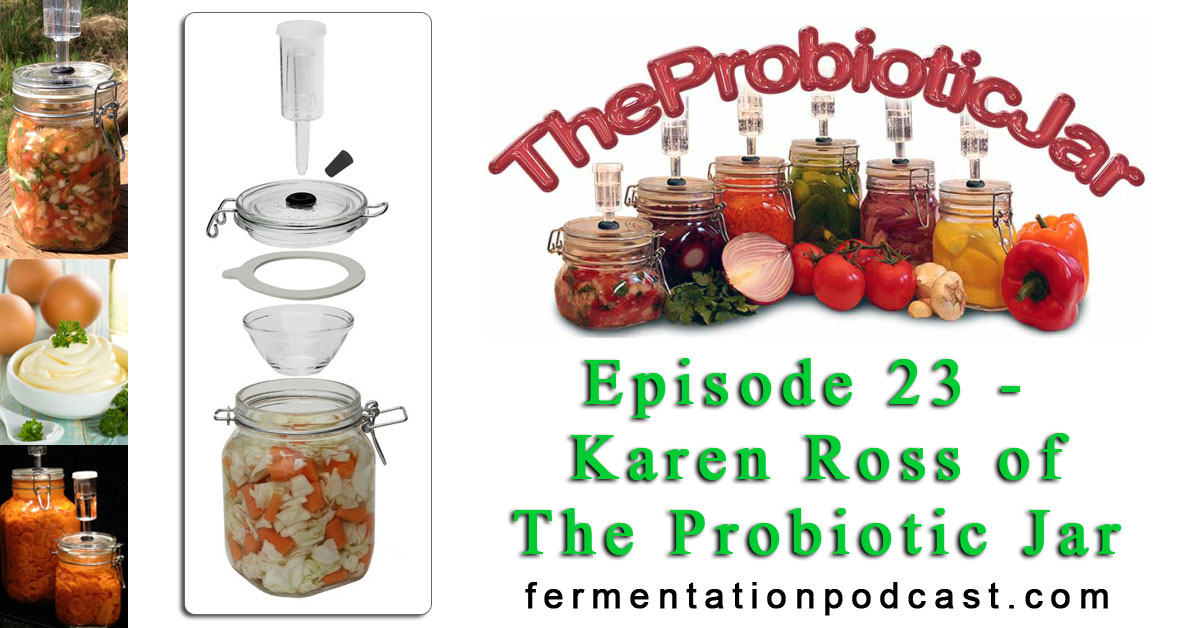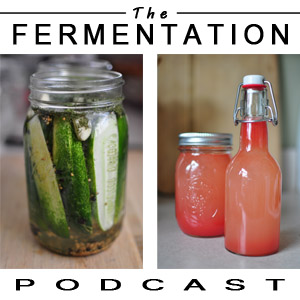I have today on the line Karen Ross, who is the creator of The Probiotic Jar, to talk about health in general and the process of anaerobic fermentation using an air-lock instead of the old-school mason jar method that I’ve been using.
I mention at the beginning of the show how there are things that circulate in the fermentation community about different methods of how to ferment pickles and other things and I think they all have their place.
On a scale of good, better, and best (with best being much farther down the scale than the other two), after using The Probiotic Jar, I think this method is just about the best you can get. If you’re like Karen, who I consider to be in the arena of a fermentation purist when it comes to the quality of a ferment and excluding oxygen and mold, and if you might be hypersensitive, then anaerobic fermentation using an airlock is by far the method you should be looking into.
The offerings out there are starting to be many whether that ends up being a ceramic crock with a water moat like from Mark Campbell Ceramics, the Kraut Source that’s stainless steel, or like we’ll be going over today, The Probiotic Jar, which is glass and also has a very handy glass bowl perfectly fitted to weigh down your ferment and have the ability to skim off oxidized brine as well as a guaranteed smooth hole in the top of the lid to make sure no oxygen gets in.
Anyways, I hope you enjoy today’s conversation and make sure to join the conversation below!
TOPICS INCLUDED IN TODAY’S FERMENTATION PODCAST:
- A bit from me on the different fermentation jars and crocks and the power of anaerobic fermentation
- Karen tells her story how she got into fermentation, coming across Sally Fallon Morrell’s book Nourishing Traditions, and how she couldn’t eat ferments created the general aerobic way that was taught due to her body not being able to process ferments because of the byproducts and chemicals that were created, so she looked for better fermentation vessels
- How Karen met Lisa Herndon of Lisa’s Counter Culture and how they were looking for a better way to ferment which led them to the idea of a fermentation vessel that didn’t leak oxygen
- Why they decided to use the Fido jar style jars over mason jars to create the system for anaerobic fermentation
- The big considerations when creating The Probiotic Jar, the availability worldwide, and how far they’re reaching people now
- Karen gives her thoughts on the difference between fermenting using other methods like the mason jar method vs an anaerobic fermentation of an air lock
- Her health crisis ten years ago of living in a house filled with mold and the challenge of regaining her health
- Karen’s theory (which I feel is correct and right along the lines of permaculture thinking of natural systems in composting) is that lactic acid bacteria clean up mold and if you give them a perfect environment, free of oxygen, they will multiply, dominate their environment, and clean it up, giving you the highest quality ferment possible
- Three ways that spoilage is either reduced or cleaned up in a ferment – reduce or eliminate oxygen, lower the pH, or add large amounts of salt versus what you can do in The Probiotic Jar
- Some great conversation on the compounds that mold forms and how it’s not just the mold spores and filaments that are bad for you, it’s the compounds that mold creates and how lactic acid bacteria and clean those up and deactivate them
- A question on whether or not to add starters like whey to a ferment that’s just starting out and how you don’t need it in The Probiotic Jar
- The strains of bacteria naturally occurring on vegetables vs the cultures required to make dairy ferments and how the process is different
- Explaining the process of back slopping and using a previous brine from a ferment to start a new one and the health benefits you might be missing from aging a ferment from start to finish to success through all the possible successions of beneficial bacteria
- All of the toxins that we come into contact in our everyday lives and how beneficial microbes can help counter those toxic effects
- How Karen still thinks the Harsh-style ceramic crocks with the water moat are still great vessels to ferment in and how no one fermentation vessel is perfect
- Can you ferment something in The Probiotic Jar, then transfer it to mason jars to hold for storage?
- Making sourdough starter in The Probiotic Jar and how that it can make your starter more resilient, last longer, and not oxidize as well as allow you to feed it less often
- Karen Ross’s food lifestyle and how she follows the Weston A. Price foundation’s principles
- How Karen loves Himalayan sea salt versus any other salt when she has the choice
- The 8 different sizes of The Probiotic Jar, what might be good to make for each size, and the 3 liter jar being the most popular size
- Starting a family business involving fermentation and the experience of a home-based business
- Karen talks about the great stories people have shared with her about getting their health back and how it keeps her doing the important work of changing people’s lives for the better through healthy fermentation
- Karen points out the idea that if water was absolutely anaerobic in nature, then fish would suffocate and the ingenious little glass brine bowl that solves the problem of too much brine being exposed to the air
- Making beet kvass in The Probiotic Jar and how the brine bowl helps to catch all of the oxidizing foam, which then when you scoop off, preserves the flavor
- Common questions people have when first using their probiotic jar such as overflow into the air lock with heavy gas producing ferments like cabbage
- The difference between the larger three piece airlock and the two piece air-lock on The Probiotic Jar
- Things not to do in The Probiotic Jar liked cooked food since there’s no lactic acid bacteria left to colonize and how to tell if food has gone bad in 3 easy signs
- The peace of mind in knowing that properly fermented vegetables are safer than raw vegetables
- Some of Karen Ross’s favorite ferments and recipes for beginners and intermediate fermenters like homemade fermented mayonnaise
- She also talks about what she teaches at her workshops including misconceptions like putting oil on top of a ferment which can harbor botulism
- Tips on fermenting in the winter time like fermenting foods in season, moving a thermometer around your house to find the perfect warm spot, and also using seedling heating mats, or even an ice chest and a hot water bottle
- Karen’s future plans to get into making fermented fish and cheese
- One last common question people ask about smelly ferments like garlic
- Some ideas on learning from other cultures that are different than us and the Ariana Mullins episode
- Starting to ferment slow using whatever method is available to you is better than no fermenting and easing yourself into eating it
RECIPES MENTIONED IN TODAY’S SHOW:
- Probiotic Jar Recipe Index
- Fermented Beet Kvass Recipe
- Carrot Stick (Herbed or Plain) Recipe
- Cold, Sinus & Flu Tonic Recipe
- Lacto-fermented Granola with Dates, Pecans, and Coconut Recipe
- Lacto-fermented Mayonnaise Recipe
LINKS FOR TODAY’S SHOW:
- Subscribe to Email (to get updates on blogs & new shows)
- Subscribe on iTunes
- Subscribe on Stitcher Radio (Android, iPhone, etc.)
- Like us on Facebook
- Follow us on Twitter
- Follow our boards on Pinterest
- The Probiotic Jar
- The Probiotic Jar Raffle for a free system
- The Probiotic Jar Free How-To Videos
- Lisa’s Counter Culture
- Top 8 Reasons Why Ferment Storage Matters
I’d love to hear your thoughts on today’s show so be sure to comment below or if you have an idea for the show, email me at paul at fermentationpodcast.com or just click on the Contact button on top of this page and fill out the form. I look forward to hearing from you!





4 comments
Skip to comment form
I was wondering what the difference is in the Probiotic Jar and the Pickle-It. Are there any differences? Have you done a comparison of the two? Love this podcast!
The Probiotic Jar is a huge improvement over other products on the market. It can hardly be considered imitation.
The Probiotic Jar is engineered to seal every time. To understand the difference, you would have to pull out the grommet of each product and compare the holes. There is a vast difference. The holes are straight and clean. Every Probiotic Jar is hand finished to take off the sharp edges that will eventually cut the grommet, and the hole is sized exactly to prevent a sloppy fit that allows oxygen to enter.
The Brine Bowl is a vast improvement for holding vegetables under the brine, and is only available in The Probiotic Jar. Other systems have flat discs that don’t really work, and some of them cost 1/3 additionally, adding to the price of the jar.
If you need help, you can talk to someone who is very knowledgeable on the phone, calls are almost always returned the next business day (if not immediately answered), and orders usually go out the next day. There is always room in any industry for someone who will show up and do a better job. 😉 I have been extremely happy with my dealings with WellnessAK, who makes the Probiotic Jar, and I wasn’t so happy with the customer service or the results with the other companies.
So what can I say? Better product. Better customer service. Better order fulfillment. Educational support.
Pickl-It has been around since at least 2008.
Kathleen at Pickl-It has done a great job of educating the world on the importance of Anaerobic fermentation, her insightful articles, patient teaching and dedicated mentoring has created a rennaissance in fermenting! There are now many knock-off products, but I suppose immitation is the sincerest form of flattery ? I believe she has created a rennaissance in home fermenting !
If you ever have the opportunity to speak with Kathleen you will be amazed by her depth of knowledge, extensive fermenting experience, and generous mentoring she provides.
Alan, you must be one of the few that can actually get along with “Kathleen”. She is rude and angry and has no people skills whatsoever. Her customer service is non-existent. I was a “pickle it” customer until a friend ask me to pull out the grommet and compare my lid to her’s. Holy cow! All kinds of chips and grooves and places for bacteria to reside and ruin my ferments. I was instantly sold and now I don’t even have to deal with “Kathleen” a benefit worth the change if the product was equal. (which it is not)